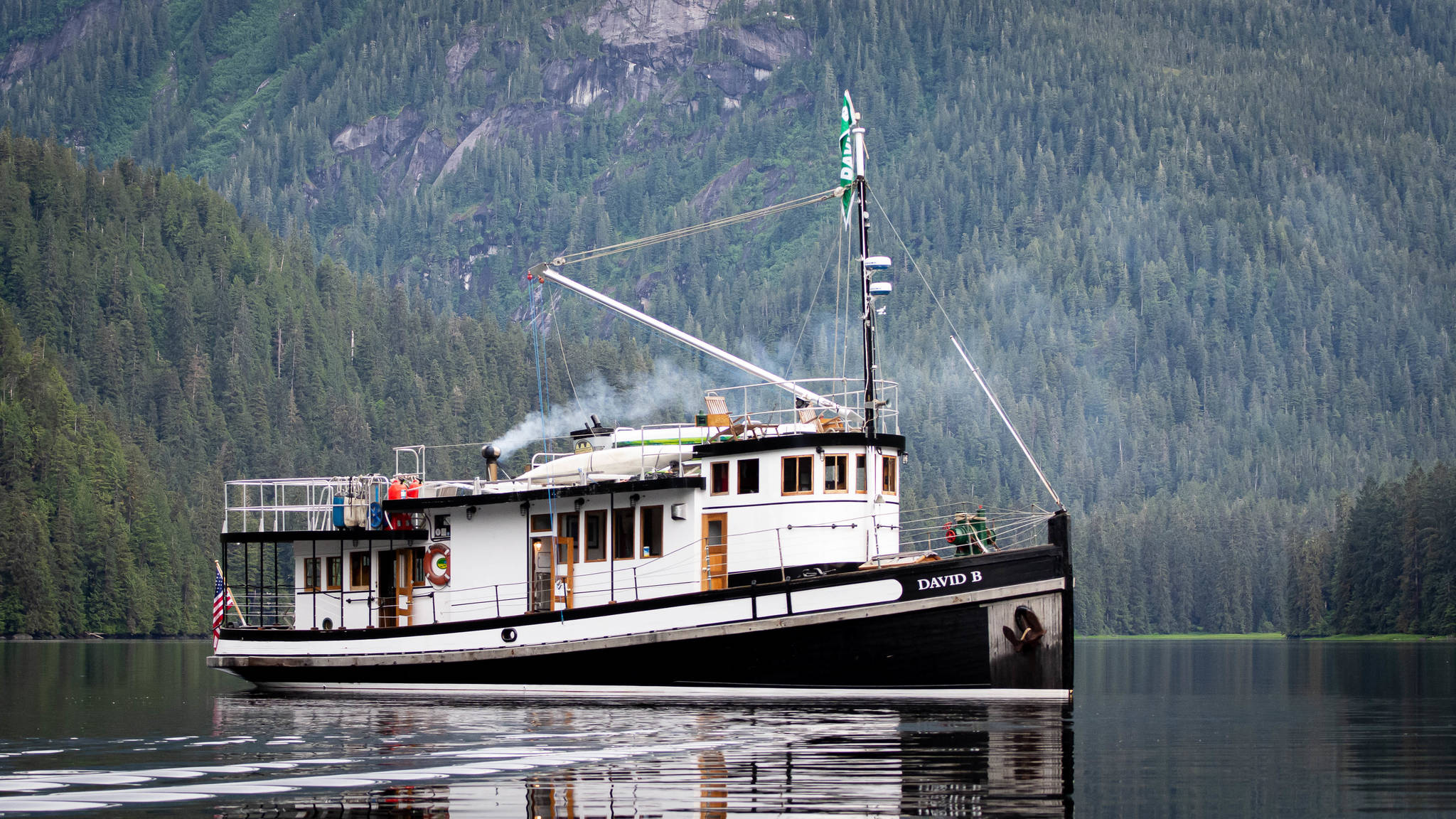By Bjorn Dihle
When Jeffery and Christine Smith were shown the David B, an ancient Bristol Bay tug, known as a monkey boat, it appeared that every cormorant in Washington State had been pooping on it for decades. The young couple were dreaming of buying and refurbishing a boat into a small cruise ship. Christine looked at the rotting 65-foot relic, then at her husband, and felt a tightening in her stomach when it became obvious Jeffery was smitten.
“We were looking for a boat with a really cool history,” Jeffery said over the phone this June, 17 years later, as he and Christine were taking a break from readying the David B to journey from their home in Bellingham to Southeast Alaska. “I knew right away that it was the David B.”
The David B was in such sorry shape that had the Smiths not purchased the boat it would likely have soon been scrapped and burnt. Despite the daunting process of resurrecting the David B, Christine quickly fell in love with the old boat. The couple learned it had been built in 1929 at a shipyard on Lake Washington for the Libby, McNeil and Libby Company. Among other things, that company owned a cannery in Bristol Bay. The boat was named after David W. Branch, the general manager of the company’s salmon operation. The David B then motored to the company’s cannery at Ekuk on the Nushagak River in Bristol Bay.
[Pride of Bristol Bay: The Bears of McNeil]
By law at the time, Bristol Bay fishermen were not allowed to use powerboats. Instead, they used 30-foot long double-ender sailboats owned by different canneries. This rule, lasting from 1929 to 1951, was largely upheld at the behest of the canneries, which owned the fleet of sailing boats. Power boats would have offered fishermen more independence from the canneries. There was a loophole in the law, though, and that’s where the David B came in. The David B, along with other monkey boats, also owned by canneries, were allowed to haul the sailboats, in a string of 10 to 15, to and from fishing grounds.
Around 2001, when Tim Troll, now Executive Director of the Bristol Bay Heritage Land Trust, was living in Dillingham, he found a double-ender sailboat rotting in the weeds near the Peter Pan Cannery. The cannery was about to turn 100 years old and Troll, fascinated by the history of Bristol Bay’s sailboat fishery, began a multi-year project that’s resulted in the publication of the book “Sailing for Salmon: The Early Years of Commercial Fishing in Alaska’s Bristol Bay.”
“What I wanted to do was collect colorful quotes about what it was like to be on those boats,” Troll said.
The book includes a collection of vintage photos depicting hardened and incredibly skilled fishermen, often described as “iron men in wooden boats.” Like today, Bristol Bay’s fishery was thriving, amounting to around 40% of the salmon caught in Alaska. Fishermen, normally working in pairs, pulled in nets by hand, while expertly managing sailboats through nuanced and sometimes dangerous conditions. Most fishermen were Scandinavian and Italian; canneries would encourage the pitting of the two ethnic groups against each other. Natives weren’t allowed in the fishery until World War II when many men left to fight in the war, and canneries were suddenly faced with a shortage of fishermen.Unsurprisingly, when the law changed in 1951 to allow motorboats in the fishery, the Bristol Bay sailboat became obsolete.
Troll, along with others, is currently finishing up refurbishing an old double-ender Bristol Bay sailboat. Their plan is to sail it from Homer to Bristol Bay next year, if the pandemic is under control, which marks the 70th anniversary since motorboats took over the fishery. Troll estimates the journey will take two weeks and plans on visiting the different communities along the way.
The end of the sailboat fishery also meant the end of monkey boats. In 1951, the David B was hauled ashore near the cannery in Ekuk along with two other monkey boats. At a certain point all three boats were scheduled to be burnt. The story goes that the owner of the cannery liked the David B, so it was spared while the other two boats were destroyed. The David B sat derelict until the end of the 1981 fishing season, when a young fisherwoman bought it from the cannery. She patched up the boat and sent it on a barge to a Seattle, where she lived on it for a few years until she started a family. Again, the David B was left derelict until Jeffery and Christine came along in 2003.
[An interview with a lifelong fisherman]
“It almost died so many times,” Jeffery said.
For eight years, Jeffery and Christine worked tirelessly bringing the David B back to life. Both worked full-time jobs during most of this time. Family and friends helped.
The end result was more than a success; you can feel all the work and love that Jeffery and Christine have poured into the boat. There’s something more about the David B that’s hard to put your finger on at first.
For many people, Jeffery admits, the David B has become something “like a secret cult.” Perhaps it’s because the boat is still powered by its original Washington Iron Works three-cylinder diesel engine and, when its motoring, it’s easy to get lost in wonder of its history. When you walk the deck and explore its insides, you’re left with the feeling the boat is a sentient thing. At anchorage, you can almost convince yourself the David B is whispering stories of all the people, places and things it has experienced during its nearly 100 years of life.
• “Pride of Bristol Bay” is a free column written by Bjorn Dihle and provided by its namesake, a fisherman-direct seafood marketer that specializes in delivering the highest quality of sustainably caught wild salmon from Bristol Bay to your doorstep.

